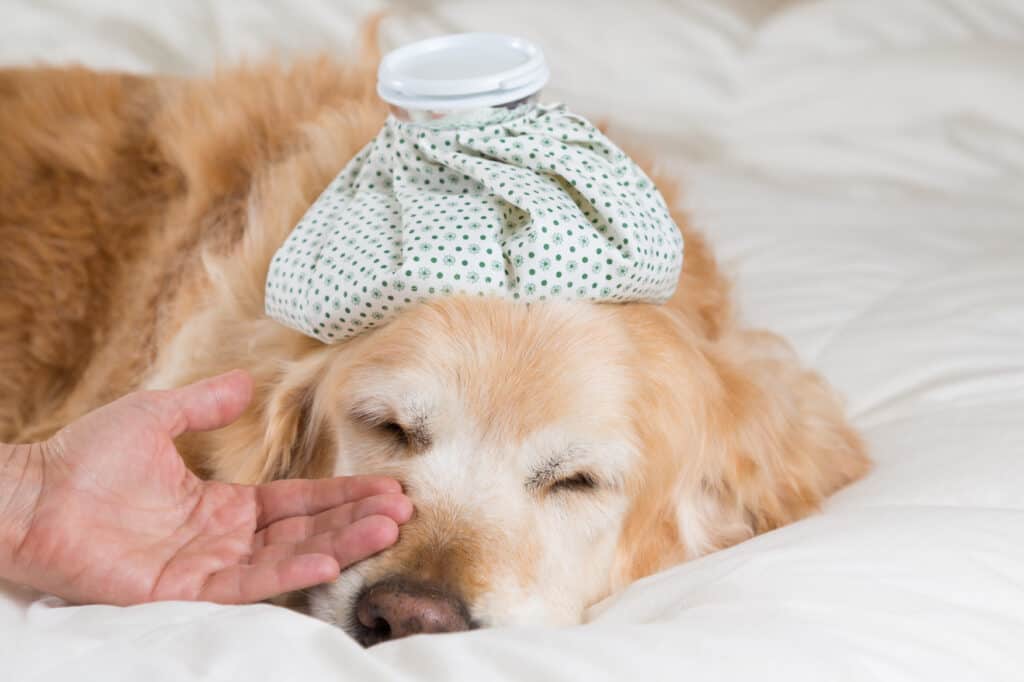If you’ve ever stepped on a nail or thorn, the first thing the person next to you asks is, “Do you have a tetanus shot?” Hopefully, you do, but what about your dog, can they get tetanus too? Unfortunately, yes. Dogs can get tetanus. Here’s what you need to know:
Tetanus, sometimes called “lockjaw,” is a condition in which your dog’s muscles overreact to any stimulus, causing them to tighten up and become rigid. It happens when the bacteria Clostridium tetani gets into the body. When C. tetani gets into a wound on your dog’s body (or yours), it makes tetanospasmin, a neurotoxin.
This toxin affects the nerves in the area and can spread to the spinal cord and brain. When the toxin binds to nerves, the nerves overstimulate the muscles they control, making them contract repeatedly. Tetanus makes dogs feel bad and makes it hard for them to walk. Severe cases affecting the muscles in the throat and diaphragm can have some harmful effects.
While dogs can get tetanus, they are resistant to it. What causes a dog to get tetanus? The C. tetani bacteria can live in the environment for many years and are spread through feces. They won’t hurt your dog if they swallow them or if they touch your healthy skin.
Things can get bad when C. tetani get into a wound on your dog, even a small one from stepping on a nail or something sharp. Puncture wounds are wet, warm, and get little oxygen, which makes them the perfect place for bacteria to grow and cause an infection.

Tetanus, spread by the bacteria C. Tetani, causes muscle spasms and lockjaw.
©nobeastsofierce/Shutterstock.com
Can Dogs Give Humans Tetanus?
Dog bites can spread tetanus, but it is very rare. Even though dog mouths do have bacteria that can be harmful to humans when they bite, they are not likely to have the bacteria that causes tetanus unless the dog was eating dirt right before it bit you.
C. tetani can also get into a dog bite wound if the person falls and gets dirt. In the same way, a dog could get tetanus from a dog bite, but it’s not likely. Tetanus infections from dog bites are caused by soil getting into the wound, not by the bite itself.
If a dog bites you, you should clean the wound well and go to the doctor for more cleaning, stitches, or antibiotics to keep the wound from getting infected. You might also need to get your tetanus shot again.
When do Symptoms of Tetanus Develop? What is the Treatment?
Tetanus symptoms typically appear 5–10 days after the initial injury. However, symptoms could occur in certain instances as soon as three days or or as late as three weeks following contact. Tetanus antitoxin may lessen the severity of clinical signs when given early in the disease. Tetanus toxin that is circulated is bound by the antitoxin, preventing it from adhering to nerve cells. Antitoxin, however, won’t help once the toxin has bonded to the nerves. Tetanus antitoxin may also have serious adverse effects. Your veterinarian will decide if tetanus antitoxin is necessary for treating your dog.

Tetanus antitoxin can lessen symptoms if given early. However, it won’t have any effect once Tetanus has bonded to the nerves.
©chemical industry/Shutterstock.com
Antibiotics and Surgery
Antibiotics are sometimes used to treat tetanus as well. Even though antibiotics don’t work on the toxin, if you get rid of the C. tetani bacteria infection, the toxin won’t be released anymore. If a wound can be found, your vet may be able to clean it out with surgery. This surgery aims to remove most of the C. tetani bacteria by cutting out the dead tissue around the wound. Tetanus can be stopped more quickly if the number of C. tetani bacteria that release the toxin into the wound decreases quickly. Dogs with tetanus need a lot of care.
Other Care
Intravenous fluids are often used to keep a dog from getting dehydrated. If a dog can’t eat, it may need a feeding tube. To keep dogs from getting pressure sores, they must sleep on clean, soft bedding and be turned over often. Because sounds and bright lights can worsen muscle spasms, affected dogs are kept in a dark, quiet place. Dogs can be given medicines to lessen the strength and severity of these muscle spasms, but they need to be closely watched for any severe side effects that these medicines could cause.
Symptoms of Tetanus in Dogs
Due to their resistance, dogs are more likely to get localized tetanus. Dogs with localized tetanus will have stiff muscles and spasms in the area around the wound. For example, if the dog was pricked on the face, their face is likely to be affected. If the dog is pricked on the leg, that leg would be stiff. They will probably be sensitive to touch in the area. This type can turn into generalized tetanus. The frightening form is generalized tetanus. Movement or powerful stimuli, such as loud noises or a lot of activity around the dog, might cause spasms. The cause of the fever is typically not a bacterial infection but rather excessive heat produced by hyperactive muscles. The entire body of the dog is impacted. The signs of generalized canine tetanus include:
- Lips retracted
- Locked jaw
- Stiffly walking without bending their legs
- Tail held rigidly up or out.
- Straight legs, as those of a sawhorse.
- Third eyelids raised
- Muscle spasms
- Breathing issues
- Fever
- Swallowing issues
- Touch-sensitive

Fever is one of the signs of tetanus in dogs.
©135pixels/Shutterstock.com
Prognosis and Prevention
Most dogs get localized diseases that go away if they get the proper treatment early enough. Most people feel better after a week of treatment, but it may take 3–4 weeks to feel completely better.
If a dog comes in lying down (unable to stand) or has other problems, like pneumonia, the outlook worsens. Various studies show that the overall survival rate is between 50 and 90%. The best way to avoid getting tetanus is to ensure that all wounds get veterinary care immediately.
Injuries should always be rinsed well and treated with antibiotics. This may help remove C. tetani spores (to further aid in the prevention). After a cut or other injury, if your dog starts to have stiff muscles or other signs of tetanus, call your vet immediately so they can check it out.
Conclusion
Tetanus is rare in dogs, but it’s still essential to keep wounds clean and free of bacteria to avoid the risk of infection. If the damage looks severe or you’re unsure how to handle it, get medical help.
Once the wound has been treated, watch for signs of infection. Call a vet for advice if it starts smelling, or your pup runs a fever. If you think your dog may have tetanus, always seek veterinarian aid immediately.
The sooner your dog gets help, the better the outcome. Even if it’s not tetanus, it could be something else that needs treatment. Your pup will thank you for taking their health seriously.
Up Next:
- Can Dogs Get Pink Eye, How Do You Treat It?
- Can Dogs Get COVID-19? Symptoms, Risks, and Prevention
- Can You Get Worms From Dogs? What Science Says
The photo featured at the top of this post is © nobeastsofierce/Shutterstock.com
Ready to discover the top 10 cutest dog breeds in the entire world?
How about the fastest dogs, the largest dogs and those that are -- quite frankly -- just the kindest dogs on the planet? Each day, AZ Animals sends out lists just like this to our thousands of email subscribers. And the best part? It's FREE. Join today by entering your email below.
Sources
- , Available here: https://www.hillspet.com/dog-care/healthcare/tetanus-in-dogs
- , Available here: https://www.thewildest.com/dog-health/tetanus-not-just-bites-and-rusty-nails
- , Available here: https://wagwalking.com/condition/tetanus
- , Available here: https://pettable.com/blog/what-are-the-signs-of-tetanus-in-dogs
Thank you for reading! Have some feedback for us? Contact the AZ Animals editorial team.






